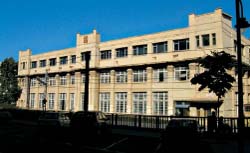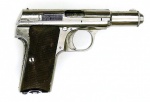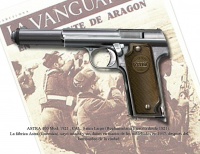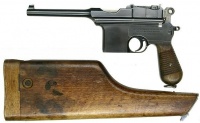Astra-Unceta y Cia SA
Astra Unceta y Cía. was a Spanish weapons manufacturer founded on July 17, 1908 under the name of Esperanza y Unceta by Juan Esperanza and Pedro Unceta. First located in the city of Eibar, the stronghold of the Basque arms industry, the company moved in 1913 to Guernica in order to increase production of the successful Campo-Giro series of pistols, produced since 1912. Several models of which, including model 1913-16, were adopted by the Spanish army, with production reaching 13,178 units. Model 1913 was mainly sold on the civilian market. These weapons were taken into service during the Spanish civil war.
During the First World War the firm supplied the French Army and Italian Army with an estimated 150,000 Ruby pistols, first produced in 1911 in 32 ACP as a licensed copy of the Llama Ruby. The pistol was accepted by the French commission of the armies four years after it began production.
Initially the firm named the gun Victoria or the Model 100, the capacity of the charger loaded with 9 cartridges in 32 ACP, a model existed in 6.35mm.
Production of 4,000 units of the Model 700 for the civilian market followed the end of the the First World War. The weapon which resembled the Ruby was named Danton and enjoyed a reputation of precision and solidity.
Contents |
From 1920 to 1946
the Spanish army, considering that Campo Giro became obsolete, an invitation to tender in order to replace its stock of guns. Esperanza y Unceta entered the market, vis-a-vis its competitor Star Bonifacio Echeverria, S.A., with the Model 400 with production starting in 1921.
Years 1920 are definitely record years for the firm as famous as like the Model 200 and Model 300 were put in production.
They had a long career and stayed into production until 1967 and 1946 respectively. </br> Two versions were envisaged: The 400 intended for the army as well as the "carabineros" or frontier troops and the 300, a slightly smaller version, intended for naval and air force officers. Model 300 will be the gun emblématique of the firm. Caliber for the 400 was the 9mm Bergman-Bayard named after the first semi-automatic pistol in use with the Spanish Army, albeit for a brief period, being later replaced by the Campo-Giro. The caliber is known to Spaniards as the "9mm Largo (or long)". During the Spanish Civil War it was found that it also tolerated well the 9 mm Parabellum cartridges supplied by Germany. Confined in 32 ACP, 9 mm run or 380 ACP, it was produced with 153.085 units. 63.000 .380cal were delivered to German Nazis, 22.390 in 32 ACP. The final destination of this large quantity of weapons remains an enigma still today. </br> Mod.200, which is a clone of FN model 1906 was produced with 234.105 specimens in several versions and calibers 25 ACP and 22 short primarily. Manufacture ceased in 1967, mainly because of new customs rules in the United States.
In 1926 Juan Esperanza left the consortium and created his own company. The company changed name and becam Unceta y the CIA.
The following year, the Spanish army launches a new program aiming at modernizing its armaments and it is once again Unceta which won the contract.
Mod.900, M 400, Mod.600
In 1927, begin the series production of Mod.900 largely inspired by famous Mauser C96 and intended for the Nationalist Chinese. Some of these models (Mod.903) were found in the hands of German soldiers during the second world war while the model F equipped the Guardia Civil.
Although the series production of this model ceased in 1937, small quantities continued to be assembled later from remaining stocks.
Astra mod.400, or Model 1921, a weapon of legend. In France the model 400 was called the “French-bean”, because its principal characteristic drawn from the ammunition as various as 9 mm Largo (original caliber), 9 mm Steyr, 9 mm Short, 9 mm Parabellum, 9 mm long Browning, 9 mm Glisenti, .38 ACP (standard cartridges).
The success of this weapon was such that it was produced until 1941. The weapon was exported to Chile, Germany, Colombia, Ecuador and France. 106,175 units were manufactured, the majority in 9 mm Largo. One also notes the production of parts in the following calibers: 7.63 Mauser, 7.65 mm Parabellum or 30 luger as well as 9 mm Parabellum.
M 400, model 1921/Spanish
- Republic destination approximately 35.000 units
- Guardia Civil approximately 10.300 units
- customs Agents approximately 1.400 units
- Corps of safety 227 units
- Republic Spanish Navy 1.650 units
- Chilean Marines 842 units exported
- Gouvernement Basque 14.800 units
- Troupe Nationalist 825 units (unknown destination)
- Armée Nationalist (Free) 27.125 units
- Armée III Reich (Hitler) 6.000 units exported
M 400, model F.ASCASO (characteristic)
During the civil war, the employees of ASTRA alined with the republicans while the owner, Mr. Uncetta, a Nationalist, annoyed with some of the new authorities of the Basque government which resulted from the elections of 1936, left the company, and over to the Nationalists. In April 1937 the town of Guernica was bombed by the aircraft of the Condor Legion, the nationalist troops seized the city later a few days and manufactures it, redirected by Mr. Uncetta, started to produce in an intensive way for the troops of Free and the armies of Third Reich.
With this completely unforeseen situation, the Républicain camp decided on the creation of two military arsenals. The first was established in the suburbs of Barcelona. It produced the M 400 model 1921 called “el puro”, which was renamed F.ASCASO in the honor of a famous anarchistic leader, friend of Buenaventura Durruti, was killed in the first battle of Barcelona. The weapon manufactured in this new republican arsenal, whose workmen were in their immense majority of the anarchist-trade unionists of powerful federation CNT, was of an about equal quality and a precision identical to that of its counterpart of the Basque Country in spite of particular dimensions, and difficulties of obvious provisioning and organization. The total production was approximately 8.000 parts. Machine pistols were also produced in this factory; they are easily identifiable by the gravage of three letters CNT on the side of the cylinder head.
Another copy of the M 400 was carried out by another arsenal in the area of Valence. It is recognizable by the presence of logo R.E. (Spain Republic) on the plates of the gun. 15.000 units were produced in this firm throughout conflict. No marking of a bench test is present on all these copies. The completion is different compared to the original because of the great diversity from the treatments of surface whose each arsenal used a clean formula. Another copy of Astra M400 (less known) named ORPHAN exists. It was manufactured in the 1930s when ASTRA exported and manufactured on the Asian continent, its exact origin to date remains obscure and unknown.
Gauge: 9 mm Largo 9 mm Bergmann-Bayard Overall length: 220 mm Length gun: 150 mm Height: 120 mm total Weight: .000 Organe grams of aiming Fixes Charger: capacity of 8 cartridges simple column, on the heel of the charger presence of marking
F.ASCASO TARRASA 9 LARGO
Safety is on the left side of the weapon, and is plastic charger Plates, of black color in a circle name F.ASCASO Cylinder head steel the logo in a circle marked F.ASCASO, TARRASA, CATALUNA
1930
a gun of indication gauges 12 for a military use of them and others was adopted by the army and the Spanish navy. Other governments adopted it too; it will be named ASTRA 500.
ASTRA model 600
Whereas the government, resulting from the civil war, carries out the closing of many arms factories, Unceta y the CIA, or Unceta y Compañia, in company of rare firms such Star Bonifacio Echeverria S.A. and Gabilondo y the CIA are authorized to continue their activities. </br> During the second world war, in spite of the official neutrality of Spain, the firm takes part in the German effort of war by the means of the program Astra Mod.600. According to the schedule of conditions of the German army, it will be confined in 9 mm Parabellum, manufacture will begin in 1943, and 10.450 weapons Astra Mod.600 will be delivered in May and June 1944. The deliveries ceased vis-a-vis the military situation on France. But the contract will be honoured well later in 1950 and 1951. The German Federal republic, to arm its police officers will require of allied the possibility of being made deliver the balance of the weapons paid in 1944. In 1950, a first delivery of 3.500 units will take place, followed, in 1951, of the balance of the contract initiated during the conflict and correspondent with 31.350 Mod.600 additional.
The other nations which imported it Astra Mod.600 are:
- Portugal, 800 specimens;
- Chile, 450 specimens;
- Jordan, 200 specimens;
- Turkey, 200 specimens;
- The Philippines, Costa-Rica, Egypt all ordered small quantities.
1946
the firm reorganizes and diversifies its activities while launching out in the production of industrial plants without to give up its shutter arms manufacturer. It will produce primarily tires, hydraulic pumps and machine tools for the textile. For the armurière production, it obtains new machines and lance with the research projects in order to renew its range. The model Astra 3000 will be the result of the one of between-them and its manufacture will begin the following year.In 1947, the model Astra Mod.3000 is put in production in order to replace the Astra Mod.300. More than 44,000 Astra 3000 would be thus manufactured until 1956, date on which Astra Modèle 4000 or it Astra Falcon take the relai.
In 1953
The firm adopts its final name of Astra y Unceta the CIA, S.a.
Of the model Astra Mod.800 in 1958 until Astra A-80, of Astra A-90, Astra-100 of the years 1980 the production packs and relates to also revolvers which are counterparts of Colt, Ruger or Smith & Wesson. Astra continues the production and the development of many reliable and elegant models which made its reputation among the amateurs of weapons and the pride of Basque industry armurière.
During 1998, under the impulse of the government Basque, a new company made up of the fusion of Astra Unceta y the CIA and Star Bonifacio Echeverria S.A. will be born. This new entity will name ASTAR, but its duration will be transitory, périclitant at the end of one year.
Code year of fabrication
|
See Table of the correspondences letters years of manufacture, to the right, for more information.
The end
Augusto Unceta-Barrenechea, the last successful manager and owner of Astra, was killed by ETA in 1977. After Astra went out of business, it was merged with STAR. This company began making weapons as ASTAR (Astra/Star = ASTAR). Astra went out of business at the same time as STAR.
Astra Arms S.A. - Switzerland
In the year 2008, 100 years after the foundation of Esperanza y Unceta (Astra Unceta y Cía), a Swiss firearms manufacturing company, founded by the Italian entrepreneur Massimo Garbarino and located in the city of Sion, has adopted the name Astra Arms S.A. and took over the rights on the Astra trademark.[1] Although the company website is yet "Under Construction" as for early April 2009, official company literature states that Astra Arms S.A. will "manufacture handguns and rifles for self-defence, target shooting, professional training and law enforcement"; the company registration available on the Internet, states its activities as "Production, commerce, maintenance and reparation of firearms of all sorts and ammunitions, as well as of electronic, mechanical and other optical accessories".[2] According to sources gathered by Italian gun magazines at the 2008 EXA arms expo (Brescia, Italy, April 12-15, 2008), Astra Arms S.A. will establish a manufacturing line for high level 1911 and a manufacturing line for AR-15 rifles, StG-15 & StG-4, to be distributed on the European, Asian, South American and African market so to circumvent American regulations currently requiring the issue of an End user certificate for every single firearm of that kind that is exported from the Country, even when manufactured for the civilian market.
See also
External links
References
- ↑ http://www.astra-arms.ch/ Astra Arms S.A. website (Under Construction)
- ↑ http://www.moneyhouse.ch/u/astra_arms_sa_CH-626.3.011.114-6.htm Astra Arms S.A. company registration






